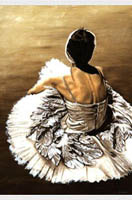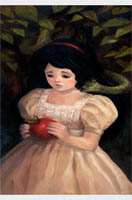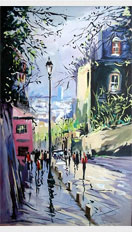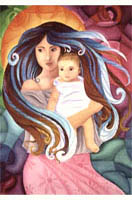Lovis Corinth
Lovis Corinth (July 21, 1858, Tapiau, East Prussia (today Gwardeisk in the Russian enclave Kaliningrad Oblast) - July 17, 1925, Zandvoort, Netherlands) was a German painter who found a synthesis of impressionism and expressionism.
He was a German painter and graphic artist. He studied in Paris and Munich, joined the Berlin Secession group, and later succeeded Max Liebermann as president. His early work was naturalistic in approach. Corinth was antagonistic toward the expressionist movement, although after a stroke in 1911 his style loosened and took on many expressionistic qualities. His colors became more vibrant, and he created portraits and landscapes of extraordinary vitality and power. A self-portrait is in the Museum of Modern Art, New York City.
Corinth showed an early talent for drawing and attended the Munich Academy in 1880, which rivaled Paris as the avant-garde art center in Europe at the time. There he was influenced by Courbet and the Barbizon school as they were interpreted by Munich artists, Wilhelm Leibl and Otto Trubner. He then traveled to Paris where he studied under William-Adolphe Bouguereau at the Academie Julian. In 1891, Corinth returned to Munich but in 1892, he abandoned the Munich Academy and joined the very first Secession. In 1894, he joined the Free Association and in 1899, he exhibited in an exhibition organized by the Berlin Secession. These nine Munich years were not his most productive and he was perhaps better known for his ability to drink large amounts of red wine and champagne.
In 1900, he moved to Berlin where he had a one-man exhibition at the famous gallery owned by Paul Cassirer. In 1902 at the age of 43, he opened a School of Painting for Women and married his first student, Charlotte Berend, some 20 years his junior. Charlotte was his youthful muse, spiritual partner and mother of his two children. She had a profound influence on him and family life became a major theme in his art during this time.
In 1911, he suffered a stroke and was partially paralyzed on his left side. With the help of his wife, a year later he was back to work with his right hand. It was during this time that landscapes became a significant part of his oeuvre. From 1915-1925, he was elected President of the Berlin Secession. In 1925, he traveled to the Netherlands to look at his favorite Dutch masters and while there, caught pneumonia and died in Zanvoort.
Corinth explored every print technique except aquatint but drypoint and lithography were his favorites. His created his first etching in 1891 and his first lithograph in 1894. In 1919, he experimented with the woodcut medium but only made 11. Like Picasso, Corinth was quite prolific and in the last fifteen years of his life, he produced more than 900 graphic works including 60 self-portraits. The landscapes he created between 1919 and 1925 are perhaps the most desirable images of his entire graphic oeuvre.







